MIGHTY NINETY
Chapter 17: OPERATION DETACHMENT part 1
USS ASTORIA CL-90 at Iwo Jima on D+2

A color photograph of Mount Suribachi taken on the morning of D-Day, 19 February 1945. The invasion beaches open up to the right side of the photograph.
-U.S. Navy photo in NARA record Group 80-G-K-3509

USS NEVADA BB-36 fires on Iwo as part of Task Force 54 during the landings of 19 February 1945.
-U.S. Navy photo in NARA record Group 80-G-K-3510
19 February 1945: D-Day
Once the order was given at 0630, the first waves of U.S. Marines began to pour onto the designated landing beaches of Iwo Jima. Ten minutes later, at 0640, the U.S. Navy commenced their support bombardment.
Ships from Task Force 58 played a role from the start. Two battleships and three cruisers had detached from the carrier force off Japan and now provided fire support alongside Task Force 54 for the landings throughout the day.
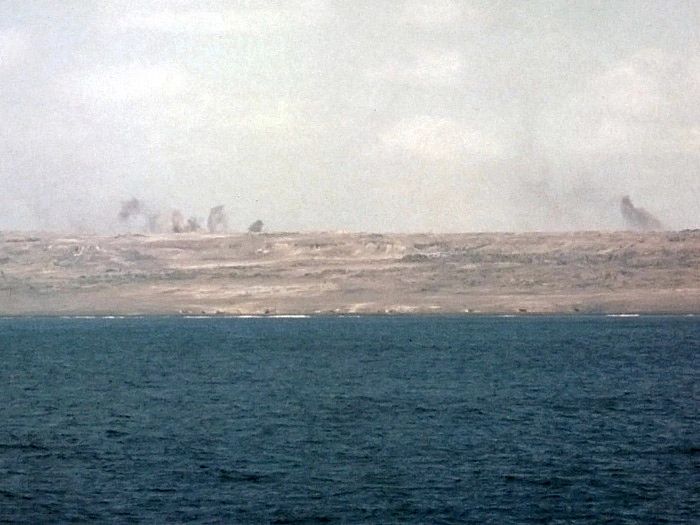
Ordnance from naval gunfire lands inland on Iwo Jima near Motoyama airfield no. 1, a D-Day objective.
-U.S. Navy photo in NARA record Group 80-G-K-3511
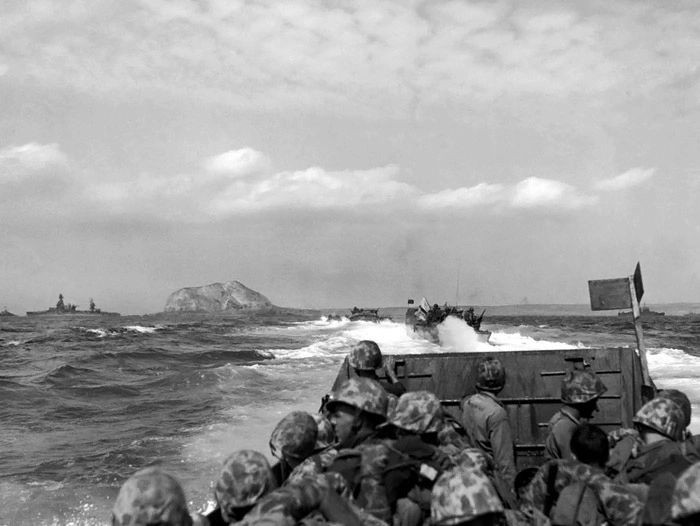
LCVP "Higgins boats" filled with Marines head toward the landing beaches on 19 February. USS ARKANSAS BB-33 provides naval gunfire support at left.
-U.S. Coast Guard photo in Brent Jones collection
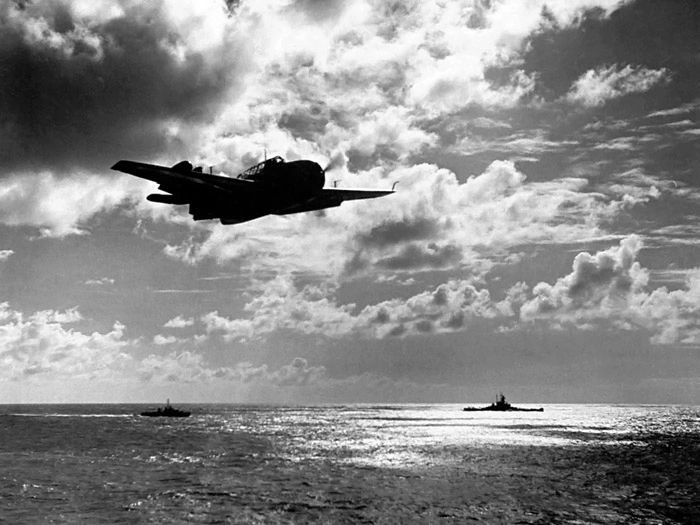
A TBM Avenger of VT-84 from BUNKER HILL heads for Iwo Jima on the morning of 19 February 1945.
-W. Eugene Smith photo in LIFE/Getty archive

U.S Marines found the invasion of Iwo difficult from the very start. The heavy volcanic ash made for slow going from the landing beach inland. The Japanese defenders of the island waited for the beaches to become congested with landing parties before opening fire.
-USMC photo in Brent Jones collection
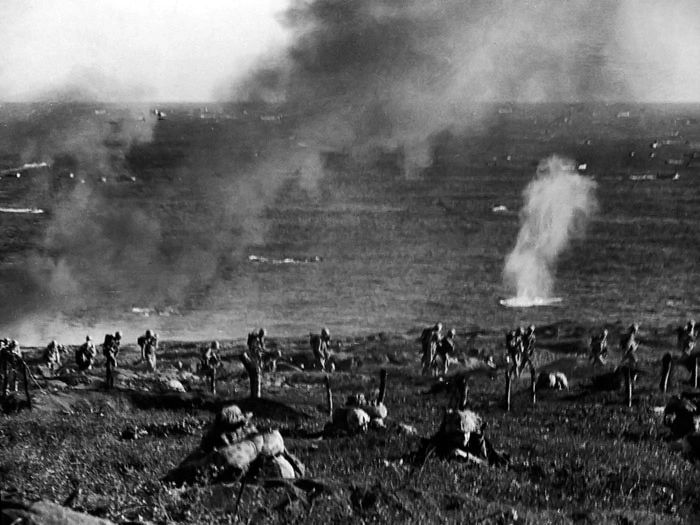
Marines under fire as they advance inland later in the morning of D-Day, 19 February 1945.
-USMC photo in Brent Jones collection

Iwo Jima at 1500 on D-Day, several hours into the invasion. Aircraft from Task Force 58 drop ordnance over the airfields at the center of the island. Conga lines of landing craft head inland from attack transports positioned out of enemy artillery range. This image was created by restoring two heavily damaged prints of photographs taken in quick succession over the island. They form a remarkable panorama of the invasion.
-U.S Navy photographs in Brent Jones collection

Marines under heavy fire during the landings. Casualties mounted quickly with no cover to treat them.
-USMC photo in Brent Jones collection
As the day progressed, it became clear that the actual ground gained would fall far short of D-Day expectations. The Japanese were too well dug in and resistance was fierce. Additional naval gunfire would be required for shore bombardment in the days that followed, and ASTORIA was called upon to assume this role.
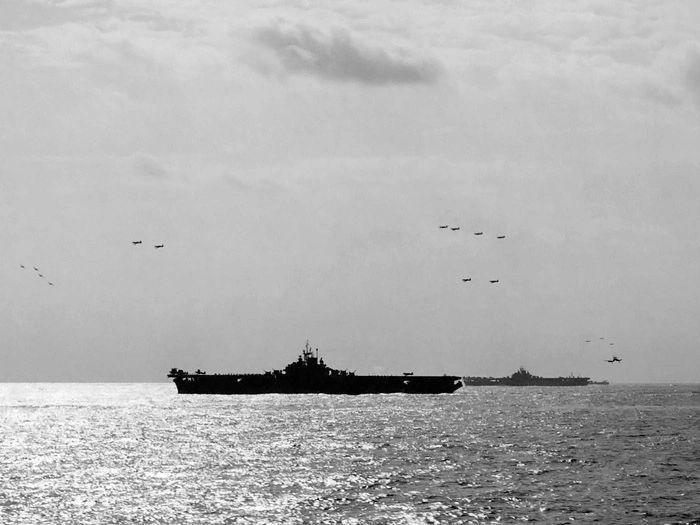
Strike aircraft return to the carriers of Task Group 58.3 on 19 February in an image taken from USS WILKES-BARRE CL-103. In the foreground is USS BUNKER HILL, with ESSEX and ASTORIA beyond.
-U.S. Navy photo in NARA record Group 80-G-307052
20 February 1945: D+1
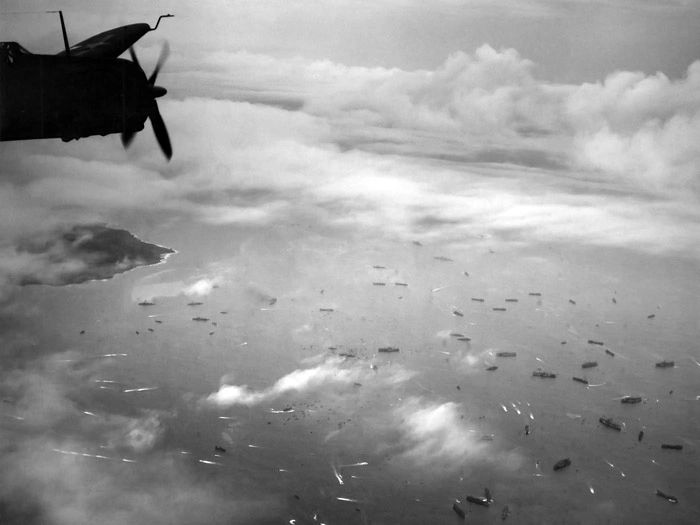
SB2C Helldivers of VB-82 from USS BENNINGTON over the Iwo invasion fleet on 20 February 1945.
-photo in collection of www.ussbennington.org
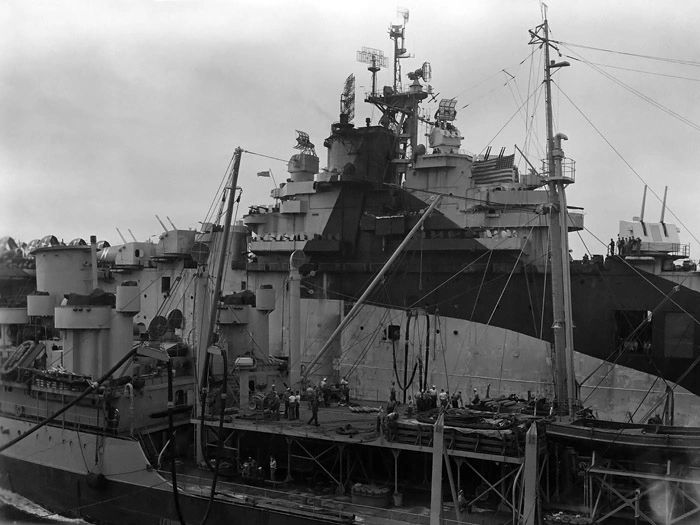
USS ESSEX CV-9 fueling from CHICOPEE AO-34 opposite ASTORIA CL-90 on 20 February 1945.
-photo taken by and courtesy of Herman Schnipper
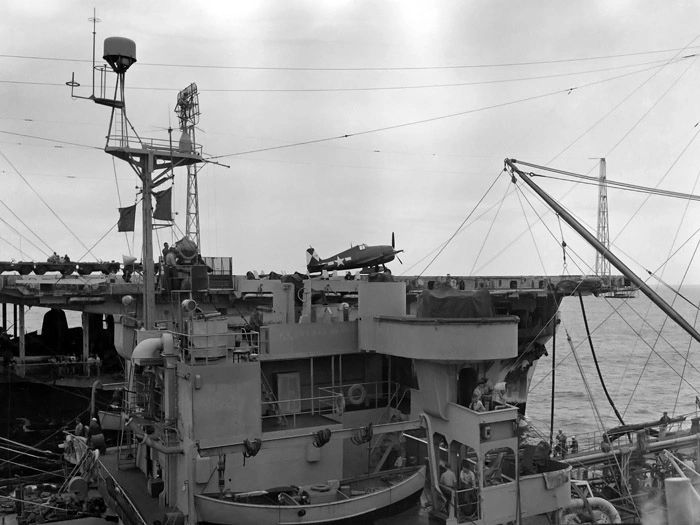
An F6F Hellcat on the USS ESSEX starboard catapult, shot from across CHICOPEE AO-34 on 20 February 1945. Note the Willys Jeeps lined up on the flight deck of ESSEX.
-photo taken by and courtesy of Herman Schnipper
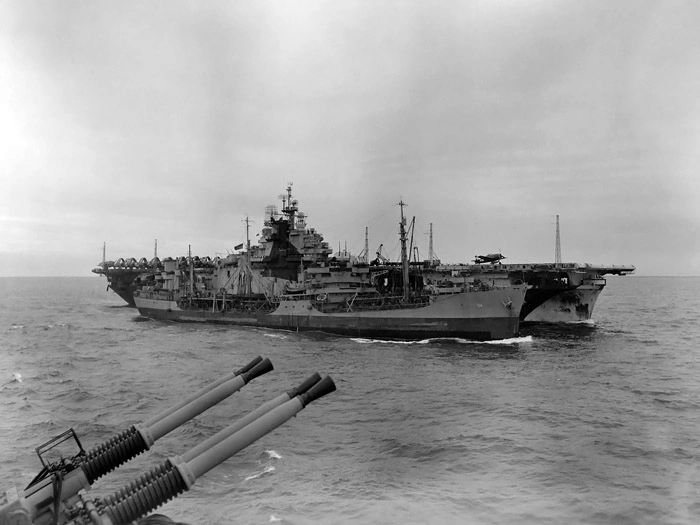
USS ASTORIA moves clear of CHICOPEE and ESSEX on 20 February. Fully replenished, she detached from the task group and headed in toward Iwo Jima.
-photo taken by and courtesy of Herman Schnipper
As Task Group 58.3 refueled 75 miles west of Iwo Jima, Cruiser Division 17 was ordered to detach and move in toward the pitched battle. ASTORIA, PASADENA, and WILKES-BARRE joined Task Force 54 as temporary Task Unit 54.1.18 along with heavy cruisers SAN FRANCISCO CA-38, BOSTON CA-69, and the four destroyers of DesDiv 106. Overnight they moved in toward the island.
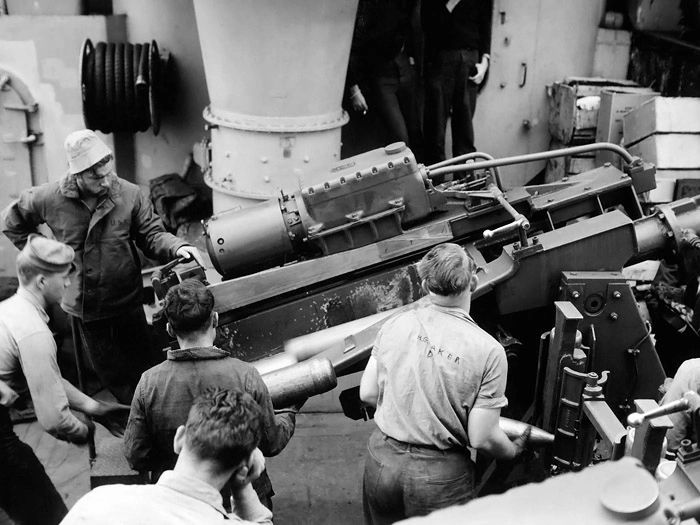
4th Division sailors practice shell and powder charge loading aboard USS WILKES-BARRE CL-103 as the cruiser heads toward Iwo Jima in the evening hours of 20 February. The next morning they would see combat for the first time.
-U.S. Navy photo in NARA record Group 80-G-307047
21 February 1945: D+2
USS ASTORIA CL-90 at Iwo Jima on D+2

A color photograph of Mount Suribachi taken on the morning of D-Day, 19 February 1945. The invasion beaches open up to the right side of the photograph.
-U.S. Navy photo in NARA record Group 80-G-K-3509

USS NEVADA BB-36 fires on Iwo as part of Task Force 54 during the landings of 19 February 1945.
-U.S. Navy photo in NARA record Group 80-G-K-3510
19 February 1945: D-Day
Once the order was given at 0630, the first waves of U.S. Marines began to pour onto the designated landing beaches of Iwo Jima. Ten minutes later, at 0640, the U.S. Navy commenced their support bombardment.
Ships from Task Force 58 played a role from the start. Two battleships and three cruisers had detached from the carrier force off Japan and now provided fire support alongside Task Force 54 for the landings throughout the day.

Ordnance from naval gunfire lands inland on Iwo Jima near Motoyama airfield no. 1, a D-Day objective.
-U.S. Navy photo in NARA record Group 80-G-K-3511

LCVP "Higgins boats" filled with Marines head toward the landing beaches on 19 February. USS ARKANSAS BB-33 provides naval gunfire support at left.
-U.S. Coast Guard photo in Brent Jones collection

A TBM Avenger of VT-84 from BUNKER HILL heads for Iwo Jima on the morning of 19 February 1945.
-W. Eugene Smith photo in LIFE/Getty archive

U.S Marines found the invasion of Iwo difficult from the very start. The heavy volcanic ash made for slow going from the landing beach inland. The Japanese defenders of the island waited for the beaches to become congested with landing parties before opening fire.
-USMC photo in Brent Jones collection

Marines under fire as they advance inland later in the morning of D-Day, 19 February 1945.
-USMC photo in Brent Jones collection

Iwo Jima at 1500 on D-Day, several hours into the invasion. Aircraft from Task Force 58 drop ordnance over the airfields at the center of the island. Conga lines of landing craft head inland from attack transports positioned out of enemy artillery range. This image was created by restoring two heavily damaged prints of photographs taken in quick succession over the island. They form a remarkable panorama of the invasion.
-U.S Navy photographs in Brent Jones collection

Marines under heavy fire during the landings. Casualties mounted quickly with no cover to treat them.
-USMC photo in Brent Jones collection
As the day progressed, it became clear that the actual ground gained would fall far short of D-Day expectations. The Japanese were too well dug in and resistance was fierce. Additional naval gunfire would be required for shore bombardment in the days that followed, and ASTORIA was called upon to assume this role.

Strike aircraft return to the carriers of Task Group 58.3 on 19 February in an image taken from USS WILKES-BARRE CL-103. In the foreground is USS BUNKER HILL, with ESSEX and ASTORIA beyond.
-U.S. Navy photo in NARA record Group 80-G-307052
20 February 1945: D+1

SB2C Helldivers of VB-82 from USS BENNINGTON over the Iwo invasion fleet on 20 February 1945.
-photo in collection of www.ussbennington.org

USS ESSEX CV-9 fueling from CHICOPEE AO-34 opposite ASTORIA CL-90 on 20 February 1945.
-photo taken by and courtesy of Herman Schnipper

An F6F Hellcat on the USS ESSEX starboard catapult, shot from across CHICOPEE AO-34 on 20 February 1945. Note the Willys Jeeps lined up on the flight deck of ESSEX.
-photo taken by and courtesy of Herman Schnipper

USS ASTORIA moves clear of CHICOPEE and ESSEX on 20 February. Fully replenished, she detached from the task group and headed in toward Iwo Jima.
-photo taken by and courtesy of Herman Schnipper
As Task Group 58.3 refueled 75 miles west of Iwo Jima, Cruiser Division 17 was ordered to detach and move in toward the pitched battle. ASTORIA, PASADENA, and WILKES-BARRE joined Task Force 54 as temporary Task Unit 54.1.18 along with heavy cruisers SAN FRANCISCO CA-38, BOSTON CA-69, and the four destroyers of DesDiv 106. Overnight they moved in toward the island.

4th Division sailors practice shell and powder charge loading aboard USS WILKES-BARRE CL-103 as the cruiser heads toward Iwo Jima in the evening hours of 20 February. The next morning they would see combat for the first time.
-U.S. Navy photo in NARA record Group 80-G-307047
21 February 1945: D+2

The view of Iwo Jima as USS ASTORIA approaches in the early morning of 21 February 1945.
-photo taken by and courtesy of Herman Schnipper

USS ASTORIA passes LSTs 723 and 642 as she moves into position off Iwo Jima on 21 February 1945. The two LSTs are fitted with racks of rockets.
-photo taken by and courtesy of Herman Schnipper
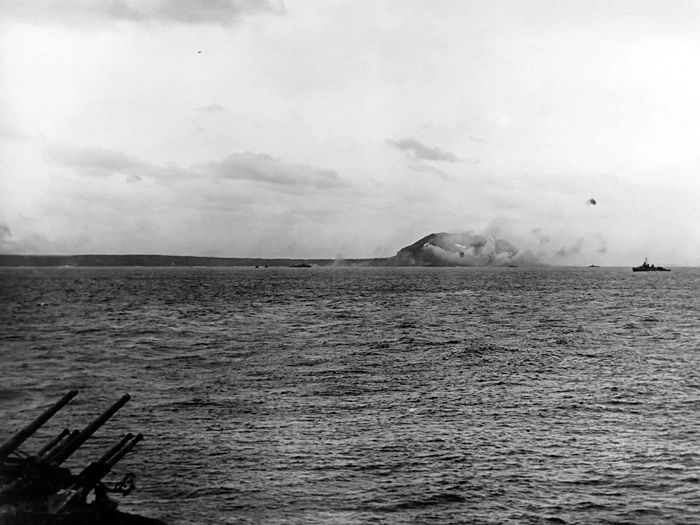
At 0740 on the morning of 21 February, an enormous barrage erupts at the base of Mount Suribachi. 5th Division Marines prepare for the assault on the mountain fortress.
-photo taken by and courtesy of Herman Schnipper

Naval gunfire, carrier-based aircraft and Marine shore batteries all contribute to the Suribachi barrage.
-photo taken by and courtesy of Herman Schnipper

A view from ASTORIA as rounds land on Suribachi from other U.S. Navy support ships on 21 February.
-photo taken by and courtesy of Herman Schnipper

Smoke pours from Mount Suribachi following the morning barrage of D+2 on 21 February 1945.
-photo taken by and courtesy of Herman Schnipper

Iwo Jima viewed northeastward with Mount Suribachi in the foreground in this photo taken during the preparatory bombardment of 17-19 February 1945. The circled area indicates where USS ASTORIA and Task Unit 54.1.18 conducted their shore bombardment from D+2 through D+3.
-U.S. Navy photo reproduced from www.history.navy.mil

USS PENSACOLA CA-24 photographed against Suribachi as ASTORIA relieved her on the morning of 21 February 1945. At right is USS BILOXI CL-80. Note the planes in formation overhead.
-photo taken by and courtesy of Herman Schnipper
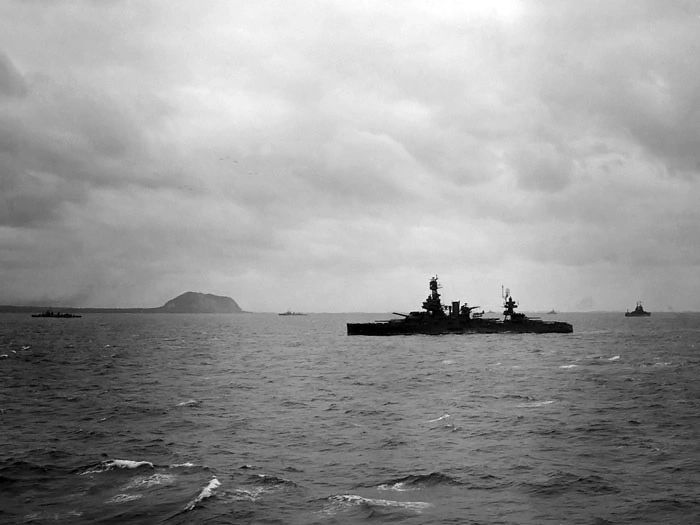
USS TEXAS BB-35 from ASTORIA CL-90 on the morning of 21 February during relief of station. The cruiser at far right is BILOXI CL-80.
-photo taken by and courtesy of Herman Schnipper

Men o' war cross paths during relief of station on 21 February 1945. Back to front are TEXAS BB-35, PASADENA CL-65 and BILOXI CL-80 photographed from ASTORIA CL-90.
-photo taken by and courtesy of Herman Schnipper

USS PASADENA CL-65 fires a salvo from her aft main battery after taking station on 21 February. Two spotter planes are visible overhead.
-photo taken by and courtesy of Herman Schnipper

A closeup of the same image of PASADENA CL-65. Note that both floatplanes are present on her fantail; PASADENA and ASTORIA had their fire spotted by FM-2 Wildcats from USS WAKE ISLAND.
-photo taken by and courtesy of Herman Schnipper

A second view of PASADENA firing on Iwo Jima. USS BOSTON CA-69 steams at left.
-photo taken by and courtesy of Herman Schnipper
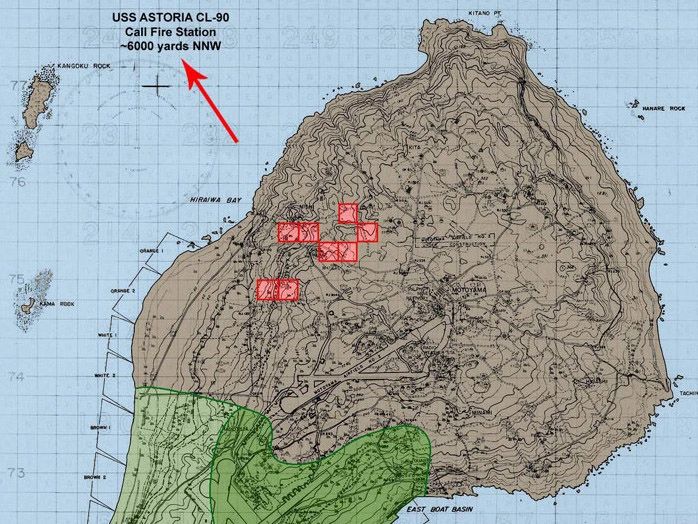
A grid map of Iwo Jima showing the call-fire assignments of USS ASTORIA CL-90 on 21 February 1945. The progress of 4th and 5th Division Marines is shown at bottom.
-grid map created by Brent Jones
Throughout the day gunfire erupted from Mighty Ninety's 6-inch main and 5-inch secondary batteries. For the 26 hours that followed, ASTORIA and her task unit rained shells onto targets across Iwo from the western side of the island.
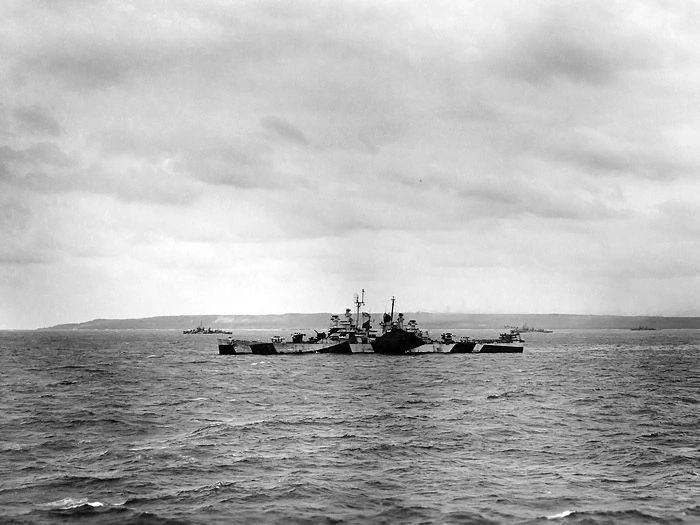
A port beam view of PASADENA CL-65 and DesDiv 106 off the northwest shore of Iwo Jima.
-photo taken by and courtesy of Herman Schnipper
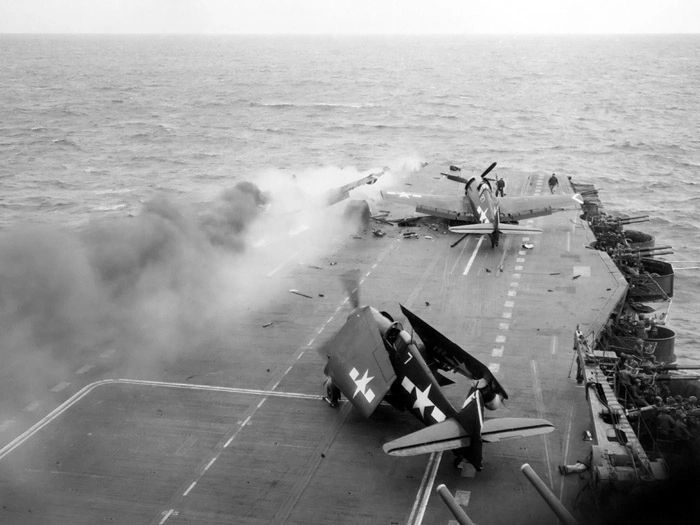
Late in the afternoon, the invasion force came under attack from Japanese aircraft. Several successive planes struck USS SARATOGA CV-3. In this photograph from the attack, note the gun crews remaining at their stations. A casualty is visible at lower right. Farther aft, fires rage on the hangar deck.
-U.S. Navy photo from Brent Jones collection
Continue to CHAPTER 18: OPERATION DETACHMENT Part 2

CLICK ON PHOTOS TO ADVANCE TO NEXT CHAPTER
BACK TO SHIP HISTORY
Sources:
Bradley, James. Flyboys. Boston, MA: Little, Brown, and Company, 2003.
Bruce, Roy W. and Leonard, Charles R. Crommelin's Thunderbirds: Air Group 12 Strikes the Heart of Japan. Annapolis, MD: United States Naval Institute, 1994.
http://commons.Wikimedia.org/wiki/Main_Page Wikimedia Commons image database.
http://earth.Google.com/ Google Earth.
Jones, Brent. Private photo and document collection.
LIFE/Getty images reproduced at http://images.google.com
MIGHTY NINETY: USS ASTORIA CL-90 cruise book. 1946.
Morison, Samuel Eliot. History of
Schnipper, Herman. Private photo and document collection.
Wheeler, Keith. The Road to Tokyo. Chicago, IL: Time-Life Books, 1979.
www.archives.gov National Archives and Records Administration WWII photo archive.
www.ussbennington.org. Home page of USS BENNINGTON CV-20.
